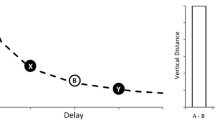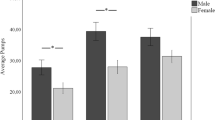Abstract
College students exhibited impulsivity if, in the first of 2 sessions, they consistently chose an immediate, small reinforcer (15-s cartoon video followed by 75 s of waiting) over a delayed, large reinforcer (55-s prereinforcer delay, 25-s video, 10 additional s of waiting), or self-control if they showed the opposite preference. Previously, Navarick (2001) found that informing impulsive participants in Session 2 that the viewing time was longer on their nonpreferred schedule reduced impulsive choice to about .50; informing self-controlled participants that the video started sooner on their nonpreferred schedule had no effect. In addition to facilitating discrimination between reinforcers, the instructions to impulsive participants could have implied a request to choose the indicated schedule (a demand characteristic) or that the nonpreferred schedule was somehow more advantageous. Effects of these potentially implicit instructions were assessed by presenting them as explicit instructions to determine if they again produced a decrease in impulsive choices in impulsive participants and no change in self-controlled participants. In contrast to the previous pattern, impulsive and self-controlled participants conformed similarly to the experimenter’s stated schedule preference, and showed similar, variable preferences in response to the general schedule characterization. The previous instructions reduced impulsivity by facilitating discrimination between the large and small reinforcers and not by conveying these implicit messages.
Similar content being viewed by others
References
BARON, A., & GALIZIO, M. (1983). Instructional control of human operant behavior. The Psychological Record, 33, 495–520.
BARON, A., KAUFMAN, A., & STAUBER, K. A. (1969). Effects of instructions and reinforcement-feedback on human operant behavior maintained by fixed-interval reinforcement. Journal of the Experimental Analysis of Behavior, 12, 701–712.
CATANIA, A. C., MATTHEWS, B. A., & SHIMOFF, E. (1982). Instructed versus shaped human verbal behavior: Interactions with nonverbal responding. Journal of the Experimental Analysis of Behavior, 38, 233–248.
CERUTTI, D. T. (1989). Discrimination theory of rule-governed behavior. Journal of the Experimental Analysis of Behavior, 51, 259–276.
GALIZIO, M. (1979). Contingency-shaped and rule-governed behavior: Instructional control of human loss avoidance. Journal of the Experimental Analysis of Behavior, 31, 53–70.
GALIZIO, M., JACKSON, L. A., & STEELE, F. O. (1979). Enforcement symbols and driving speed: The overreaction effect. Journal of Applied Psychology, 64, 311–315.
HAYES, S. C., BROWNSTEIN, A. J., ZETTLE, R. D., ROSENFARB, I., & KORN, Z. (1986). Rule-governed behavior and sensitivity to changing consequences of behavior. Journal of the Experimental Analysis of Behavior, 45, 237–256.
HYTEN, C., MADDEN, G. J., & FIELD, D. P. (1994). Exchange delays and impulsive choice in adult humans. Journal of the Experimental Analysis of Behavior, 62, 225–233.
JOYCE, J. H., & CHASE, P. N. (1990). Effects of response variability on the sensitivity of rule-governed behavior. Journal of the Experimental Analysis of Behavior, 54, 251–262.
LEFRANCOIS, J. R., CHASE, P. N., & JOYCE, J. H. (1988). The effects of a variety of instructions on human fixed-interval performance. Journal of the Experimental Analysis of Behavior, 49, 383–393.
MATTHEWS, B. A., CATANIA, A. C., & SHIMOFF, E. (1985). Effects of uninstructed verbal behavior on nonverbal responding: Contingency descriptions versus performance descriptions. Journal of the Experimental Analysis of Behavior, 43, 155–164.
MATTHEWS, B. A., SHIMOFF, E., CATANIA, A. C., & SAGVOLDEN, T. (1977). Uninstructed human responding: Sensitivity to instructions in conflict with contingencies. Journal of the Experimental Analysis of Behavior, 27, 453–467.
NAVARICK, D. J. (1985). Choice in humans: Functional properties of reinforcers established by instruction. Behavioural Processes, 11, 269–277.
NAVARICK, D. J. (1996). Choice in humans: Techniques for enhancing sensitivity to reinforcement immediacy. The Psychological Record, 46, 539–554.
NAVARICK, D. J. (1998). Impulsive choice in adults: How consistent are individual differences? The Psychological Record, 48, 665–674.
NAVARICK, D. J. (2001). Control of impulsive choice through biasing instructions. The Psychological Record, 51, 549–560.
NAVARICK, D. J. (2004). Discounting of delayed reinforcers: Measurement by questionnaires versus operant choice procedures. The Psychological Record, 54, 85–94.
NAVARICK, D. J., & FANTINO, E. (1976). Self-control and general models of choice. Journal of Experimental Psychology: Animal Behavior Process, 2, 75–87.
ORNE, M. T. (1962). On the social psychology of the psychological experiment: With particular reference to demand characteristics and their implications. American Psychologist, 17, 776–783.
RAIA, C. P., SHILLINGFORD, S. W., MILLER, H. L., JR., & BAIER, P. S. (2000). Interaction of procedural factors in human performance on yoked schedules. Journal of the Experimental Analysis of Behavior, 74, 265–281.
TORGRUD, L. J., & HOLBORN, S. W. (1990). The effects of verbal performance descriptions on nonverbal operant responding. Journal of the Experimental Analysis of Behavior, 54, 273–291.
WEINER, H. (1970). Instructional control of human operant responding during extinction following fixed-ratio conditioning. Journal of the Experimental Analysis of Behavior, 13, 391–394.
Author information
Authors and Affiliations
Corresponding author
Rights and permissions
About this article
Cite this article
Navarick, D.J. Analysis of impulsive choice: Assessing effects of implicit instructions. Psychol Rec 54, 505–522 (2004). https://doi.org/10.1007/BF03395489
Published:
Issue Date:
DOI: https://doi.org/10.1007/BF03395489




